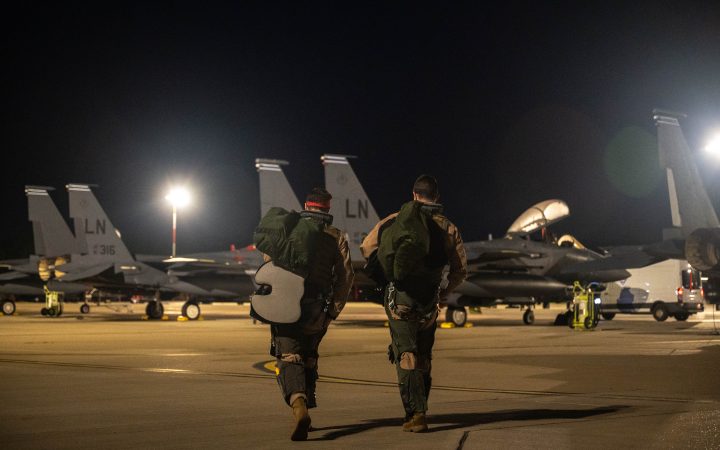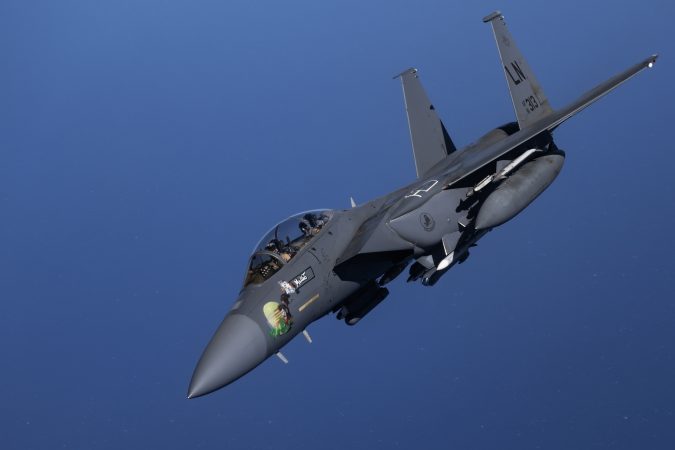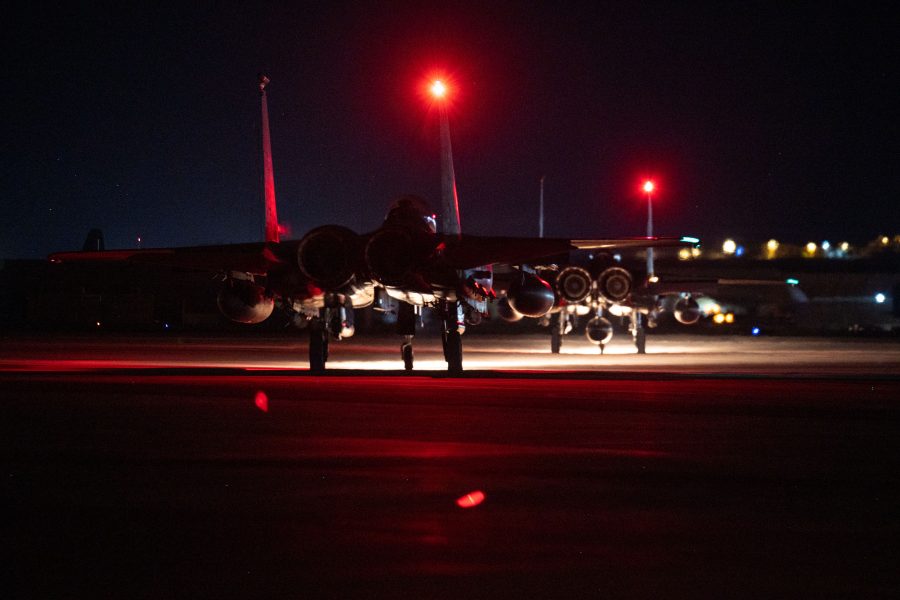This is the second article in a multipart series based on exclusive interviews with nine Airmen who helped respond to Iran’s April 13 attack on Israel. To read Part 1, ‘Silver Star Airmen,’ click here. To complete the series, read Part 3, ‘Did We Do Enough’
RAF LAKENHEATH, U.K.—On April 13, Capts. Trace Sheerin, Brian Tesch, Logan Cowan, and Gabriel Diamond were set to fly the second scheduled patrol of the night from an undisclosed location in the Middle East.
Members of the 494th Fighter Squadron, they had already watched fellow F-15E crews take off earlier that night, heading over the desert to confront Iran’s retaliatory attack on Israel.
Intelligence and command and control feeds made clear the attack was big—jets were expending all their firepower within 30 minutes, “including air-to-ground munitions, which would be like the last thing you have on the jet to try to take out some of those drones,” Tesch said.
Yet when the crews asked if they would be taking off earlier than planned, the answer came back “no.” Finally, they climbed into their jets. “We had just started the first engine, the canopy had just closed, and then off in the distance, I see about two dozen maintenance folk and other people sprinting and running out of buildings towards the bunkers,” Tesch said.
Ballistic missiles were now either approaching the base, which was close to Israel, or being hit by the Iron Dome defense system.
The base declared “Alarm Red”—meaning it was facing an imminent threat; troops were directed to underground bunkers. A Patriot air defense battery on the base started firing interceptors.
“I look over my shoulder and it just looks like the Fourth of July,” Teach said. “I remember, usually I couldn’t see the paper on my on my knee because it’s just dark. It’s night. There’s no lighting out there. But I could see, like, clear as day. I could read everything on the paper just from the explosions lighting up the cockpit.”
The second shift of F-15Es weren’t the only Strike Eagles on the flight line. The first two aircraft to take off that night, flown by Maj. Benjamin Coffey and Capt. Lacie Hester and Lt. Col. Curtis Culver and Lt. Col. Timothy Causey, had returned to base after expending all their firepower, and Culver and Causey’s jet got an integrated combat turn—being reloaded and refueled with the engines running—in a breakneck time of 32 minutes.

But Coffey and Hester’s jet had a “hung ordnance,” meaning a missile that had not fired. They were planning on hopping over to a second plane when the Alarm Red sounded, and with their jet not ready to take off yet, they headed to the bunkers.
Once there, however, Coffey and Hester came to grips with the situation. Their fellow aviators were still defending against the attack—and they had a jet still on the flight line, if they could just get it prepped for launch amid the Alarm Red.
“I remember looking at Sonic [and saying], ‘We got to go out. We haven’t done enough yet. We can do more. We can just do one more sortie, there’s one more jet. Let’s just take it and go,’” Coffey said. “And she’s like, ‘Yeah, we got to go.’”
To make that happen, though, they needed a crew chief and maintainers to volunteer to leave the bunker.
“One of them stood up, Senior Airman Freer, and said, ‘Yeah, I’m a crew chief,’” Coffey recalled. “’You want to go out there right now and launch this ship?’ [He said] ‘Absolutely,’ so we three of us, left the bunker. A few other folks joined us, and Sonic and I got in, started cranking. He stayed plugged in with us. When we cleared him off, he’s like, ‘Nope, until you taxi, I’m going to be right here. My job’s to get you out.’ So he chose, over and over again, with all that stuff going on, to stay out there.’”
While the alarm kept going as they prepared for takeoff, there was a small gap in the air defense by the time Coffey and Hester were ready for takeoff, giving them an opening to go.
Meanwhile, the second patrol got the order from the squadron commander: launch to survive. With missiles and debris raining down around the base, the sky was now the safest place for the fighters to be.
“The problem is, we can’t take off until we have an arming crew … pull the arming handles, the pins and make it so that we can effectively use our aircraft and weapon systems,” said Cowan.
On the flight line, Staff Sgt. Kendra Wertsbaugh and her team were responsible for a final inspection and arming munitions just before takeoff. They had watched the maintenance crew pull off the speedy combat turn just as the alarm red had started. Now, they were in a van, preparing to head to the bunker.
“We had two more aircraft that were not ready to be launched, but they were at chocks, waiting to taxi to be launched. So I said, you know, we have to turn around,” Wertsbaugh said. “We have these last two aircraft, who knows how long this alarm red is going to last? So if we do this now, it’ll be done, and after that we can get inside.”
While the aircraft taking off would be safer in the air, the ground crews would have no such luck. But Wertsbaugh was not deterred.
“Nobody else is going to do this,” she said. “I was assigned to this part. I need to stick with it.”
Staff Sgt. Ethan Tarver had helped resolve issues on jets before the alarm sounded, then he and other maintainers directed others to go to the bunkers while they stayed on the flight line to get the final jets off.
“We know how to do it in that moment. There’s so much going on, there’s so much process. There’s no room for emotion,” he said.
In their cockpits, Cowan, Sheerin, Tesch, and Diamond watched as “a team of like 10 people swarm our jets,” Cowan said.
“I don’t even know if they were the arming crews. People would run up to the jet to arm us up and then continue running to the bunker,” Tesch said.
A dozen Airmen were decorated for their actions that night, including Master Sgt. Timothy Adams, who was awarded a Bronze Star Medal for overseeing the maintainers under fire and remaining on the flightline.
Ready to go, the jets taxied for takeoff—and then stared down a runway with active air defense going off on either side.
“The takeoff corridor that we had was out of the way of the battery firing,” Cowan said. “We took off, and I wanted to become invisible, because we still had other base defenses, and we have the other bases in the area that have their own defense zones we needed to avoid.”
Behind Cowan and Diamond, Sheerin and Tesch saw the jet’s afterburner go out at around 3,000 feet. In the darkness, with lights and explosions all around, they couldn’t tell if their flight lead had made it.
“I was convinced they had been shot down from our own air defense or hit something on the way up,” Tesch said. “So that, for me, was probably the scariest moment of, ‘Hey, it’s our turn to go. They just got hit. Now we have to follow them through that cluster of debris and flaming chunks of metal.’”
Sheerin kept the jet low over the runway, knowing debris wasn’t falling directly on it and the air defense was positioned to fire parallel to the runway, rather than across it.
“it felt kind of like a drag race,” Sheerin said. “So you are racing the air defense basically. [Tesch] talked about the Fourth of July lights—you’re chasing these fireworks and racing them down the runway. And then once we had enough airspeed, and we were past the edge of the runway, just pitching the nose up pretty, pretty high, trying to get away from the ground as fast as possible.”
In the air, Capt. Matthew Eddins and Capt. Garrett Benner were part of the first alert crews to launch against the attack and were returning to base after handing things over to the second alert jets. As they drew near, they saw chaos ensue.

“When you’re under night vision goggles, you can see probably the greatest firework show you’ve ever seen, and lots of stuff raining down from who knows where, but it’s hard to tell if that’s 100 miles away or or 10 miles away or if that’s directly above me,” Benner said.
At the operations desk, Maj. Clayton Wicks and others had decided to stay at their posts as the primary focal communications point for all the jets even as the alarm went off. Now, they needed to decide whether or not they should have Eddins and Benner land with the Alarm Red still in effect.
“We decided that having them divert and land somewhere else was not the best course of action,” Wicks said. “I mean, the base hadn’t actively been hit, so we’re like, if we determined that having them go somewhere else, that absolutely takes them out of the fight, whereas if we can get them down here, we might still be able to put them through the ICTs and get it back airborne. And in all likelihood, our base was still the safest place for them. So just stay airborne as long as you can, and land once you don’t have fuel to stay airborne anymore.”
With hung ordnance and low fuel, Eddins and Benner decided to land. After holding off for a moment to let the jets on the ground take off, they landed on the base’s backup runway.
“At that point, I was just focused on landing,” Eddins said. “I know that runway was not the best. About 1,000 feet down that runway is actually a little bump. So when you land and you hit that bump, it actually brings you up airborne again. You have to bring it back down with the crosswinds. It was definitely not my greatest landing.”
But they made it. On the ground, with the Alarm Red still in effect, jets with hung ordnance had to be carefully positioned on the flight line so as to not be too close together. But the danger to the base was starting to fade.
At the ops desk, Wicks got the word from the Combined Air Operations Center: Stop launching jets. “Save it for tomorrow, because we don’t know what’s going to happen tomorrow,” they told him. High above, some U.S. fighters remained in the air—as did a number of Iranian drones.
Read Part 1, ‘Silver Star Airmen,’ and Part 3, ‘Did We Do Enough.’
494th Fighter Squadron Decorations
Silver Star Medal
- Maj. Benjamin Coffey
- Capt. Lacie Hester
Bronze Star Medal
- Maj. Clayton Wicks
- Master Sgt. Timothy Adams
Distinguished Flying Cross
- Lt. Col. Curtis Culver (V)
- Lt. Col. Timothy Causey (V)
- Capt. Logan Cowan (V)
- Capt. Gabriel Diamond (V)
- Capt. Trace Sheerin (V)
- Capt. Brian Tesch (V)
- Capt. Matthew Eddins (C)
- Capt. Garrett Benner (C)
- Capt. Austin Leake (C)
- Capt. Stepan Volnychev (C)
- Capt. Claire Eddins
- Capt. Carla Nava
- Capt. Kyle Abraham
- Capt. Eric Edelman
(V) indicates a Valor device, (C) indicates a Combat device
Air and Space Commendation Medal
- Capt. Alexander Thennes
- Master Sgt. Michael Bialaski
- Tech. Sgt. Brandon Brown
- Staff Sgt. Sarah Moir
- Staff Sgt. Kendra Wertsbaugh
- Staff Sgt. Daniel White
Air and Space Achievement Medal
- Staff Sgt. Michael Wright
- Staff Sgt. Ethan Tarver
- Senior Airman Ardo Dia
- Senior Airman Sanders Joseph
- Senior Airman Rico Sanchez
- Airman First Class Treyvon Walker
